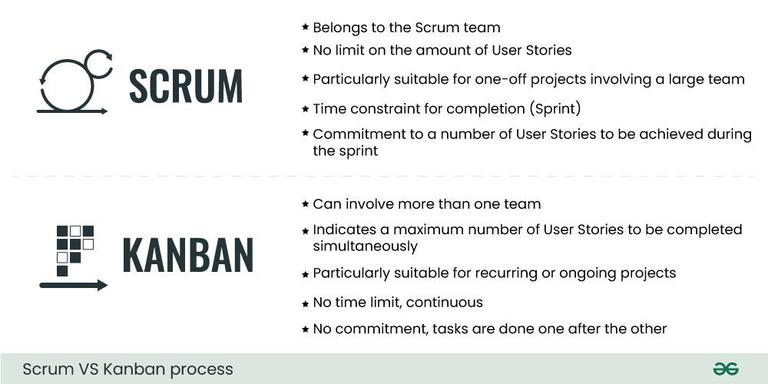Kanban vs Scrum Board | Software Development
Last Updated :
11 Jan, 2024
In Software Development, Scrum and Kanban boards are popular tools used by teams to organize and track their work. These visual boards help teams manage tasks efficiently. A Scrum Board, associated with the Scrum methodology, uses fixed-time sprints and focuses on completing tasks within those time frames. On the other hand, a Kanban Board, linked to the Kanban methodology, emphasizes a continuous flow of work without fixed time constraints. Both boards have distinct features that cater to different project needs, offering teams flexibility in how they approach and manage their work.

Kanban vs Scrum Board
What is the Scrum Board?
A Scrum Board is a visual tool used in the Scrum project management framework. It’s like a big chart divided into columns, usually labelled “To Do,” “In Progress,” and “Done.” This board helps teams keep track of their work during a fixed period called a sprint. Tasks or goals are represented on sticky notes or cards and move from one column to another as they progress. The board provides a clear snapshot of what needs to be done, what’s currently being worked on, and what’s completed. It promotes collaboration and transparency, making it easier for the team to manage and complete tasks effectively.
What is the Kanban Board?
A Kanban Board is a visual tool used in the Kanban project management approach. It’s like a big board divided into columns representing different stages of work, such as “Backlog,” “Ready to Pull,” “In Progress,” “Testing,” and “Done”. Unlike Scrum, Kanban doesn’t have fixed time frames; it focuses on a continuous flow of work. Tasks are represented by cards and move through the columns as they progress in the workflow. The board helps teams visualize their work, identify bottlenecks, and optimize their processes for efficiency. It provides a flexible and adaptive way to manage tasks and deliver work consistently.
Difference between Scrum Board and Kanban Board

Difference between Scrum Board and Kanban Board
|
In Scrum, planning occurs at the beginning of each sprint, with tasks committed to for the duration of the sprint.
|
Kanban allows for continuous planning, enabling teams to adjust and introduce new tasks at any time.
|
|
Scrum defines specific roles like Scrum Master, Product Owner, and Development Team with distinct responsibilities.
|
Kanban is often less prescriptive about roles, allowing teams more autonomy and flexibility in how they collaborate.
|
|
Scrum Boards typically have columns like “To Do,” “In Progress,” and “Done” to represent the workflow during a sprint.
|
Kanban Boards may have various columns reflecting different stages of the workflow, providing a more detailed view of the work process.
|
|
Scrum works in fixed iterations (sprints), and changes are usually addressed at the beginning of a new sprint.
|
Kanban operates with a continuous flow, enabling changes to be introduced at any time, promoting adaptability.
|
|
Changes are usually addressed at the start of a new sprint in Scrum.
|
Kanban allows for changes to be introduced at any time, promoting adaptability.
|
|
Scrum uses fixed-time sprints for task planning.
|
Kanban doesn’t have fixed time frames; it relies on continuous flow.
|
|
Scrum typically limits the work in progress by planning tasks within the sprint, avoiding excessive multitasking.
|
Kanban often uses explicit WIP limits on columns to manage and control the flow of work, preventing overload and enhancing efficiency.
|
|
Scrum delivers increments of work at the end of each sprint, providing regular and predictable delivery milestones.
|
Kanban promotes a continuous delivery approach, allowing for the release of work as soon as it is completed, providing more frequent and ongoing deliveries.
|
Conclusion
In conclusion, the choice between a Scrum Board and a Kanban Board depends on the nature of your project and team preferences. If you prefer a structured approach with fixed timeframes and iterations, Scrum might be a better fit. On the other hand, if you value a more flexible and continuous workflow without strict time constraints, Kanban could be the way to go. Both boards offer effective visual tools to manage tasks, but understanding the differences helps in selecting the one that aligns better with your project’s needs. It’s essential to consider factors like project complexity, team dynamics, and the desired level of adaptability when making your choice.
Share your thoughts in the comments
Please Login to comment...